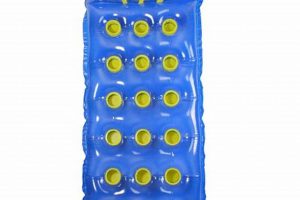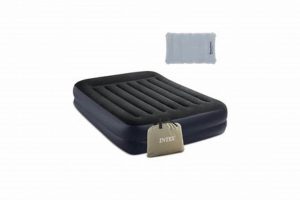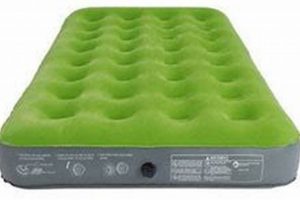A portable device designed for inflating air mattresses without a constant power source constitutes a significant convenience for camping, travel, or temporary home use. These devices integrate a battery that can be replenished, offering freedom from electrical outlets and manual pumping.
The advent of such portable inflation solutions enhances user experience by reducing setup time and physical exertion. Historically, air mattress inflation relied on manual pumps or mains-powered electric alternatives. Rechargeable models provide a more versatile and user-friendly option, especially in environments where accessibility to power is limited.
The following sections will explore the specific features, advantages, considerations, and maintenance practices associated with these convenient inflation tools, providing a detailed overview of their functionality and practical application.
Rechargeable Air Mattress Inflator
Optimizing the performance and lifespan of a portable inflation device requires adherence to several key guidelines. The following tips are intended to promote efficient operation and minimize the risk of damage or malfunction.
Tip 1: Battery Management: Fully charge the inflator before initial use. Subsequent charging should occur when the battery indicator signals depletion, avoiding complete discharge whenever possible. Consistent partial charging is generally preferable to infrequent full depletion cycles.
Tip 2: Nozzle Compatibility: Verify the nozzle attachment fits securely into the air mattress valve. Using an incorrect or loose-fitting nozzle can lead to inefficient inflation or damage to both the inflator and the mattress.
Tip 3: Inflation Monitoring: Avoid over-inflation. Periodically check the firmness of the air mattress during inflation to prevent bursting or seam damage. Refer to the mattress manufacturer’s recommendations for optimal pressure.
Tip 4: Environmental Considerations: Operate the device in a clean and dry environment. Exposure to excessive dust, moisture, or extreme temperatures can negatively impact the inflator’s performance and longevity.
Tip 5: Storage Practices: When not in use, store the device in a cool, dry place away from direct sunlight. Ensure the battery is partially charged before prolonged storage to prevent deep discharge and potential battery degradation.
Tip 6: Maintenance Schedule: Regularly inspect the inflator for signs of damage, such as cracks, frayed cords, or loose connections. Clean the air intake vents periodically to prevent airflow obstruction.
Tip 7: Safety Precautions: Never leave the inflator unattended while in operation. Keep it out of reach of children and pets to prevent accidental activation or injury.
Following these recommendations will contribute to the consistent and reliable operation of the inflation device, maximizing its utility and extending its service life.
The subsequent section will address troubleshooting common issues and providing guidance on selecting the most appropriate model for individual needs.
1. Battery Capacity
Battery capacity, a critical attribute of any portable inflation device, fundamentally determines its operational autonomy. It is measured in units of milliampere-hours (mAh) or ampere-hours (Ah), representing the amount of electrical charge the battery can store and subsequently deliver. A higher battery capacity directly correlates with the device’s ability to inflate a greater number of air mattresses, or a larger mattress, on a single full charge. For instance, a model with a 5000 mAh battery will generally provide significantly more inflation cycles than one with a 2000 mAh battery, assuming similar motor efficiency and load demands. This is particularly relevant in situations where access to a power source for recharging is limited or unavailable, such as during camping trips or in remote locations. Without sufficient battery capacity, the utility of the device is severely compromised.
The practical implications of battery capacity extend beyond merely the number of inflations. Inflation speed, mattress size, and even ambient temperature can influence the rate of battery depletion. Inflating a king-size mattress requires more energy than inflating a twin-size mattress. Similarly, operating the device in colder temperatures can reduce battery performance due to altered electrochemical reactions within the battery itself. Furthermore, the efficiency of the motor and impeller design within the inflation device plays a role; a more efficient design will extract more work per unit of energy from the battery, extending its useful life. Therefore, when selecting a rechargeable air mattress inflator, assessing the battery capacity in conjunction with anticipated usage patterns is essential for making an informed decision.
In summary, battery capacity serves as a primary determinant of the utility and operational range of a rechargeable air mattress inflator. Insufficient capacity renders the device ineffective in situations lacking readily available power, while adequate capacity provides convenience and independence. Understanding the interplay between battery capacity, mattress size, environmental factors, and device efficiency is crucial for maximizing the value and usability of this portable inflation solution. Challenges remain in balancing increased battery capacity with device size and weight, a trade-off manufacturers continuously strive to optimize.
2. Inflation Speed
Inflation speed, a key performance metric for a rechargeable air mattress inflator, dictates the time required to fully inflate an air mattress. This parameter is primarily determined by the airflow rate, typically measured in cubic feet per minute (CFM) or liters per minute (LPM), and the pressure the device can generate, expressed in pounds per square inch (PSI). A higher CFM or LPM value indicates a greater volume of air being delivered per unit of time, resulting in faster inflation. Adequate pressure is also crucial; sufficient PSI ensures the mattress reaches its desired firmness without undue delay. Delays cause inconvenience, which is a factor in the selection of a suitable device. For example, an inflator with a low CFM rating may require significantly longer inflation times, particularly for larger air mattresses, negating the convenience expected from a portable inflation solution.
The practical implications of inflation speed are considerable. In situations where time is a constraint, such as setting up camp in adverse weather conditions or preparing a guest room for late arrivals, a faster inflation speed offers a distinct advantage. Conversely, an excessively slow inflation rate can lead to frustration and wasted effort. Furthermore, the motor’s ability to maintain consistent inflation speed under load is a critical factor; some inflators experience a
noticeable reduction in airflow as the air mattress fills, prolonging the overall inflation time. Manufacturers often specify inflation times for particular mattress sizes as a performance indicator. Devices intended for inflating larger mattresses, such as queen- or king-sized models, often feature higher CFM ratings than those designed for smaller, single-person airbeds.
Ultimately, inflation speed is a significant determinant of user satisfaction with rechargeable air mattress inflators. A balance must be struck between inflation speed, battery life, and device size and weight. Models prioritizing rapid inflation may consume battery power more quickly or require larger, heavier components. Therefore, selection should be guided by a realistic assessment of anticipated usage scenarios and the relative importance of speed versus portability and runtime. The optimal choice will vary depending on individual needs and preferences, and a thorough comparison of available models is necessary to make an informed decision.
3. Nozzle Variety
Nozzle variety, pertaining to a rechargeable air mattress inflator, significantly impacts its utility and compatibility. The availability of different nozzle types ensures the inflator can accommodate a range of valve designs found on various air mattresses and inflatable products, directly affecting the inflator’s versatility and practical application.
- Standard Bayonet Nozzle
This nozzle type, commonly included with many inflators, features a twist-and-lock mechanism. Its design fits a common air mattress valve, providing a secure connection that minimizes air leakage during inflation. The prevalence of this valve type on many consumer air mattresses makes this nozzle a standard inclusion. Its absence limits the inflator to only specific mattress types.
- Pinch Valve Adapter
Some inflatables utilize a pinch valve system, requiring a specialized adapter that fits into the valve and allows air to enter. Inflatables such as pool toys, rafts, and some older air mattress designs often employ this valve type. Without this adapter, the inflator is rendered unusable with these items.
- Boston Valve Adapter
Boston valves are commonly found on higher-end air mattresses, inflatable boats, and kayaks. These valves are characterized by a wider opening and a more robust sealing mechanism. An adapter designed specifically for Boston valves ensures a tight, leak-proof connection, enabling rapid and efficient inflation of these larger volume inflatables.
- Universal Cone Adapter
A universal cone adapter is designed to fit a variety of valve sizes and shapes, providing a degree of flexibility when inflating items with non-standard or proprietary valve designs. This type of adapter is particularly useful when dealing with a diverse collection of inflatables, ensuring compatibility without the need for multiple specialized nozzles.
The breadth of nozzle options directly dictates the range of inflatables a rechargeable air mattress inflator can service. A limited nozzle selection restricts the device’s applicability, diminishing its overall value and convenience. Conversely, a comprehensive assortment of nozzles maximizes versatility, enabling the inflator to be used across a wider spectrum of inflatable products. This flexibility enhances the user’s experience and reinforces the device’s utility as a multi-purpose inflation solution.
4. Portability Factors
The utility of a rechargeable air mattress inflator is intrinsically linked to its portability. Weight, dimensions, and the presence of a carrying case are all critical factors determining ease of transport and storage, affecting its suitability for various applications. A heavier, bulkier inflator becomes less practical for backpacking or air travel, whereas a lightweight, compact model enhances convenience in such scenarios. For example, an inflator exceeding five pounds may prove cumbersome for extended hiking trips, limiting its viability for inflating camping mattresses. Conversely, a sub-two-pound model with a compact form factor presents a more manageable solution, easily fitting into a backpack or luggage compartment.
The inclusion of a dedicated carrying case further contributes to portability by providing protection during transit and facilitating organized storage. A well-designed case safeguards the inflator and its accessories from damage, prevents accidental activation, and streamlines packing and unpacking. Models lacking a carrying case may be more susceptible to damage and present a greater logistical challenge, particularly when transporting multiple items. The case should also be constructed from durable materials that can withstand the rigors of travel and outdoor use. The physical characteristics of the battery pack itself, especially its shape and location within the device, may also impact overall ergonomics and ease of handling during inflation. Devices designed for handheld operation benefit from a balanced weight distribution.
Ultimately, portability factors significantly influence the practical value of a rechargeable air mattress inflator. Lighter, more compact models with durable carrying cases offer enhanced convenience and adaptability, making them well-suited for a wider range of applications. However, achieving optimal portability often involves trade-offs with other features, such as battery capacity and inflation speed. Consumers must therefore carefully consider their specific needs and prioritize accordingly, selecting a model that effectively balances portability with performance and durability. The intersection of portability and functionality remains a central design consideration in the development and refinement of these devices.
5. Durability Metrics
Durability metrics are paramount in evaluating the long-term value and reliability of a rechargeable air mattress inflator. These metrics encompass various factors that determine the device’s resistance to wear, damage, and functional degradation under typical operating conditions, influencing its lifespan and overall cost-effectiveness.
- Housing Material Composition
The type of plastic or metal used to construct the inflator’s housing directly impacts its ability to withstand physical impacts and environmental stressors. Polycarbonate and ABS plastics offer reasonable impact resistance, while aluminum alloys provide superior protection against deformation and corrosion. An inflator with a robust housing is less susceptible to cracking or breaking from accidental drops or exposure to extreme temperatures, prolonging its functional lifespan. The selection of housing material dictates the inflator’s resilience to daily use and potential mishandling.
- Motor Lifespan (Duty Cycle)
The motor is a critical component, and its expected lifespan, often expressed in terms of duty cycle or operational hours, is a primary indicator of overall durability. A higher duty cycle suggests the motor can operate for extended periods without overheating or experiencing premature failure. Brushless motors, compared to brushed alternatives, generally offer longer lifes
pans and reduced maintenance requirements. Understanding the motor’s specifications provides insight into the inflator’s ability to consistently deliver adequate airflow over time, impacting long-term performance. - Battery Cycle Count and Chemistry
The rechargeable battery’s cycle count, representing the number of full charge/discharge cycles it can endure before significant capacity degradation, influences the inflator’s long-term usability. Lithium-ion batteries, common in portable devices, exhibit varying cycle lives depending on the specific chemistry and manufacturing quality. A higher cycle count indicates greater longevity and reduced need for battery replacement. The battery chemistry also impacts factors like self-discharge rate and sensitivity to temperature extremes, affecting overall durability and reliable performance.
- Component Stress Testing and IP Rating
Manufacturers often employ stress testing procedures to evaluate the durability of individual components and the assembled inflator. These tests may involve subjecting the device to extreme temperatures, humidity, vibration, and repeated impacts. An Ingress Protection (IP) rating, if specified, indicates the inflator’s resistance to dust and water ingress, providing a standardized measure of its ability to withstand harsh environmental conditions. A higher IP rating signifies greater protection against environmental contaminants, enhancing the inflator’s reliability and longevity in outdoor or demanding settings.
These durability metrics, taken together, provide a comprehensive assessment of a rechargeable air mattress inflator’s ability to withstand the rigors of regular use and varying environmental conditions. A thorough understanding of these factors enables consumers to make informed purchasing decisions, selecting models that offer both reliable performance and long-term value. Prioritizing durability leads to reduced replacement costs and greater overall satisfaction with the chosen inflation solution.
Frequently Asked Questions
The following questions address common inquiries regarding rechargeable air mattress inflators, providing factual information and guidance on their use and maintenance.
Question 1: What is the typical charging time for a rechargeable air mattress inflator?
Charging times vary depending on battery capacity and charging method (e.g., AC adapter, USB). Most models require 4-8 hours for a full charge. Refer to the manufacturer’s specifications for precise charging durations.
Question 2: How many air mattresses can a fully charged rechargeable air mattress inflator inflate?
The number of inflations depends on battery capacity, mattress size, and desired firmness. Typically, a fully charged inflator can inflate 2-4 queen-sized air mattresses before requiring a recharge. Smaller mattresses allow for more inflations.
Question 3: Can a rechargeable air mattress inflator be used to deflate an air mattress?
Many models include a deflation function. This reverses the airflow, enabling rapid deflation. Check the product specifications to confirm this feature.
Question 4: What safety precautions should be observed when using a rechargeable air mattress inflator?
Avoid over-inflating mattresses to prevent bursting. Do not operate the inflator in wet conditions. Keep the device out of reach of children. Monitor the inflator during operation to prevent overheating.
Question 5: How should a rechargeable air mattress inflator be stored when not in use?
Store the inflator in a cool, dry place away from direct sunlight. Ensure the battery is partially charged to prevent deep discharge during prolonged storage. A carrying case protects the device from dust and physical damage.
Question 6: What are the key factors to consider when selecting a rechargeable air mattress inflator?
Consider battery capacity, inflation speed, nozzle variety, portability, and durability. Assess the intended use (e.g., camping, home use) and prioritize features accordingly. Read reviews to gauge user satisfaction and identify potential issues.
The information presented addresses prevalent concerns related to rechargeable air mattress inflators, offering a foundation for their effective and safe utilization.
The following segment will explore maintenance strategies to prolong the life of this tool.
Conclusion
This examination of the rechargeable air mattress inflator has outlined its operational characteristics, performance metrics, and maintenance requirements. Battery capacity, inflation speed, nozzle variety, portability considerations, and durability assessments form the basis for informed purchasing and effective utilization of this device. Understanding these factors enables users to optimize performance and extend the service life of the chosen model.
Proper maintenance and adherence to recommended usage guidelines are paramount. Continued advancements in battery technology and motor design promise further improvements in efficiency and portability, solidifying the position of the rechargeable air mattress inflator as a practical solution for convenient inflation needs.




![Walmart Air Mattress Cost: Prices & Best Deals [Year] Organic & Natural Mattress Buyer’s Guide: Non-Toxic Sleep Solutions Walmart Air Mattress Cost: Prices & Best Deals [Year] | Organic & Natural Mattress Buyer’s Guide: Non-Toxic Sleep Solutions](https://mattressworldpa.com/wp-content/uploads/2025/07/th-6522-300x200.jpg)


